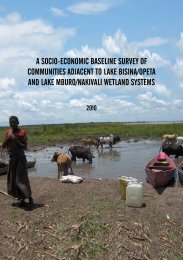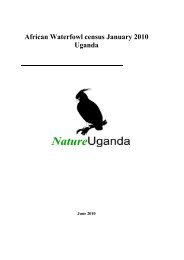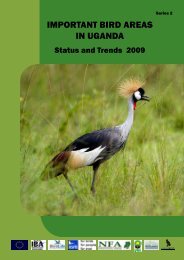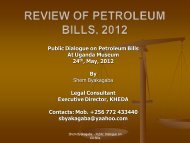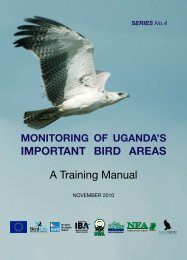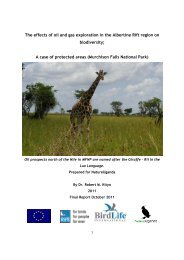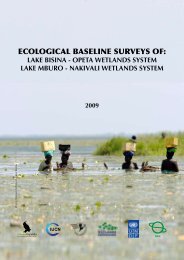the economic valuation of the proposed ... - Nature Uganda
the economic valuation of the proposed ... - Nature Uganda
the economic valuation of the proposed ... - Nature Uganda
You also want an ePaper? Increase the reach of your titles
YUMPU automatically turns print PDFs into web optimized ePapers that Google loves.
from non-timber forest products was estimated at UShs<br />
573,622,450 as shown below.<br />
NTFPs livelihood value<br />
UShs 9,579/ha/year<br />
Size <strong>of</strong> impact area<br />
7186 ha<br />
Annual benefit stream<br />
UShs 68,834,694/year<br />
Present Value <strong>of</strong> NTFPs<br />
UShs 573,622,450 (or US$337,425)<br />
C. PHARMACEUTICAL VALUE<br />
Mabira CFR is rich in biodiversity. The area <strong>of</strong> impact <strong>of</strong><br />
<strong>the</strong> <strong>proposed</strong> degazettement represents 24 percent<br />
<strong>of</strong> <strong>the</strong> total and, <strong>the</strong>refore, is likely to affect overall<br />
biodiversity richness. Some biodiversity will definitely<br />
be lost.<br />
Biodiversity richness <strong>of</strong> a forest represents an option<br />
value; and it is perhaps one <strong>of</strong> <strong>the</strong> least tangible<br />
benefits <strong>of</strong> <strong>Uganda</strong>’s forests (Bush et al 2004). The value<br />
<strong>of</strong> biodiversity lies partly in <strong>the</strong> development <strong>of</strong> plant-<br />
based pharmaceuticals (Bush et al 2004; Emerton &<br />
Muramira 1999; Mendelsohn & Balik 1997; Howard<br />
1995; Pearce & Moran 1994; Ruitenbeek 1989). In<br />
addition to undiscovered plant-based pharmaceuticals,<br />
Howard (1995) reported that <strong>the</strong>re is potential in wild<br />
c<strong>of</strong>fee genetic material. According to Bush et al (2004),<br />
<strong>Uganda</strong>’s farmed c<strong>of</strong>fee is being hit by a Fusarium wilt<br />
against which no known cultural or chemical practices<br />
appear to succeed and wild c<strong>of</strong>fee is known to be<br />
resistant to it (Bush et al 2004).<br />
Various estimates have been made <strong>of</strong> <strong>the</strong> value <strong>of</strong><br />
forest biodiversity. Ruitenbeek (1989) estimated <strong>the</strong><br />
biodiversity <strong>of</strong> Korup Park in Cameroon at ₤0.1/ha/<br />
annum. Pearce & Moran (1994) provided a range <strong>of</strong><br />
values for tropical forest, ranging from US$0.1/ha to US<br />
$ 21/ha.<br />
Mendelsohn & Balik (1997) produced a value for<br />
undiscovered plant-based drugs in tropical forest with<br />
average plant endemism <strong>of</strong> US$3/ha. Howard (1995)<br />
suggested that <strong>Uganda</strong>’s forests are not as species rich<br />
as Korup Park and <strong>the</strong> country would be less competitive<br />
in say supply <strong>of</strong> Prunus africana. Bush et al (2004),<br />
suggest an average value for biodiversity at US$1.50/ha/<br />
year. Simpson et al (1994) estimated <strong>the</strong> pharmaceutical<br />
value <strong>of</strong> ‘hot spot’ land areas in various countries <strong>of</strong> <strong>the</strong><br />
world. Their estimate <strong>of</strong> <strong>the</strong> willingness to pay (WTP) <strong>of</strong><br />
<strong>the</strong> pharmaceutical companies was $2.10 for Tanzania<br />
and $1.1 for Ivory Coast. Hence <strong>the</strong> Bush et al (2004) is a<br />
very reasonable estimate. Using this estimate <strong>the</strong> future<br />
pharmaceutical opportunities foregone in <strong>the</strong> impact<br />
area would be UShs 18,324,300/year (using an exchange<br />
rate <strong>of</strong> 1 US$ = UShs 1700). This annual benefit stream<br />
translates into a present value <strong>of</strong> UShs 152,702,500 (or<br />
US$898,825).<br />
D. DOMESTIC WATER CONSERVATION<br />
During Focus Group Discussions with communities<br />
surrounding Mabira CFR and living in <strong>the</strong> forest enclaves,<br />
<strong>the</strong>y revealed that to <strong>the</strong>m <strong>the</strong> most important use <strong>of</strong><br />
<strong>the</strong> forest was for water collection. All <strong>the</strong> surrounding<br />
communities and those living in <strong>the</strong> forest enclaves, said<br />
<strong>the</strong>y get <strong>the</strong>ir water from <strong>the</strong> forest. This view tallies with<br />
<strong>the</strong> observation <strong>of</strong> Bush et al (2004), where <strong>the</strong> forests<br />
surveyed across <strong>Uganda</strong> represented important sources<br />
<strong>of</strong> water for local communities.<br />
Bush et al (2004) estimated <strong>the</strong> mean value <strong>of</strong> water<br />
provision for both humans and livestock per household<br />
at UShs 18,415 per annum, and ranges from UShs 12,078<br />
per annum for Budongo CFR to UShs 30,928 per annum<br />
for Rwenzori Mountains National Park. In this report,<br />
<strong>the</strong> value for Budongo CFR which is relatively similar to<br />
Mabira CFR was used in estimating community water<br />
benefits.<br />
Muramira (2000) estimated <strong>the</strong> number <strong>of</strong> households<br />
in <strong>the</strong> enclaves and within <strong>the</strong> proximity <strong>of</strong> Mabira at<br />
15,631. Assuming population growth rate <strong>of</strong> 3.4 percent<br />
per annum (UBOS 2002), by 2007, this population would<br />
have increased to about 19,753 households. Therefore<br />
multiplying <strong>the</strong> mean value <strong>of</strong> water provision <strong>of</strong> UShs<br />
The Economic Valuation <strong>of</strong> <strong>the</strong> Proposed Degazettement <strong>of</strong> Mabira CFR | 2011 41



